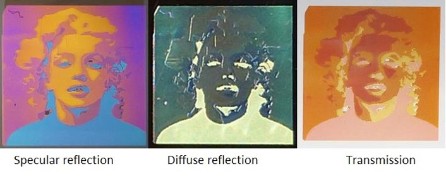Multiview color reproduction
Whatever the technology used (laser printing, 3D printing, textiles, nano-structured surface), color management for printing remains a major scientific challenge due to the multiple parameters involved in dye diffusion as well as substrates: spectrum and direction of illumination, direction of observation, polarization, spectral sensitivity of the sensor used. The objective is to predict as precisely as possible the color rendering of the printed matter, but with a minimal calibration phase.
Spectral models for light scattering (MMIS project) are designed to facilitate digital color management (IAU project) while addressing the wide variety of printing technologies used today and the wide range of media. These spectral models allow not only color management for opaque prints seen through light reflection, but also for double-sided prints seen by light transmission (backlighting). They also open up to new 3D printing technologies (partnership with Océ Print Logic).
New multiview image concepts have been developped, where a single printed medium displays different images according to the lighting and observation conditions. This is the case, for example, with double-sided prints displaying different images when illuminated from the front or back side, or colored lustres produced by laser on glass (Nanoparticles project).

A printed paper placed at the window of a room receives mainly light from outside, but also ambiant light from the room (around 10% of the total illumination). From outdoors, we therefore see the recto-image by light reflection (image on the left) whereas from indoors we see the superposition of the recto- and verso-images by light transmission (image in the middle). In this example, the verso-image has been designed thanks to a spectral flux transfer model, taking into account the optical properties of the support, the inks, and the illumination conditions, in order to display one image different from the one viewed from outdoors. When the lighting conditions are modified, for exemple by a shadow, the image visible from outdoors becomes also visible from indoors.
Mazauric, S., Hébert, M., Simonot, L., & Fournel, T. (2014). Two-flux transfer matrix model for predicting the reflectance and transmittance of duplex halftone prints. JOSA A, 31(12), 2775-2788.
Dalloz, N., Mazauric, S., Fournel, T., & Hébert, M. (2017). How to design a recto-verso print displaying different images in various everyday-life lighting conditions. Electronic Imaging, 2017(8), 33-41.

Example of image (1 x 1 cm) produced on glass plate produced by laser irradiation, displaying different colors according to the illumination and observations conditions(in collaboration with the Nanoparticles project of the Laboratoire Hubert Curien).
Destouches, N., Martínez-García, J., Hébert, M., Crespo-Monteiro, N., Vitrant, G., Liu, Z., ... & Lefkir, Y. (2014). Dichroic colored luster of laser-induced silver nanoparticle gratings buried in dense inorganic films. JOSA B, 31(11), C1-C7.
